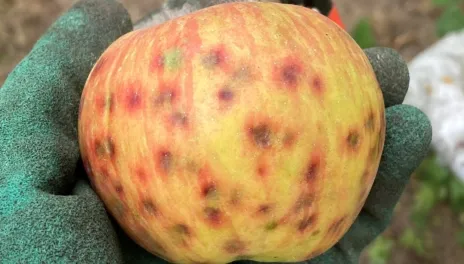How Are Your Apples?
After 17 years in the CREC orchard, I find there is still more to go wrong. Last year’s drought was broken in the fall by over 8 inches of rain and the moisture continued this past spring through mid-July with over 14 inches of rain. The orchard loved it! This moisture has also been beneficial to insects and I see more insect damage in the fruits as I harvest them this year. There are also physiological problems that occur due to calcium issues related to the moisture.
In the picture that accompanies this article, we see bitter pit pockmarks on a green Honeycrisp apple. Bitter pit is a significant problem in Honeycrisp and requires diligent calcium and nitrogen management in commercial orchards. Warm soil, high organic matter and moisture allows nitrogen to be released from the organic matter at the ‘wrong’ time. These increased levels of nitrogen in the summer lead to more bitter pit at harvest. I’ve seen a little here and there over the years, but THIS single fruit is Amazing (in a bad way).
Honestly, I manage these no differently than a better-than-average homeowner (I prune and thin the fruit and keep grass from underneath the trees. OK, the students thin most of the fruit and I do follow-up when I catch my breath in mid-August.) I don’t spray them. I mow the grass short in the fall and all the leaves blow away or get mulched when mowed. No apples remain on the tree or on the ground.
What can a homeowner do to manage bitter pit? I would say: Not much. Here is what University of California says: “Bitter pit is related to low calcium levels in fruit but is not usually directly related to the amount of calcium applied. Cultural practices can influence calcium availability to fruit, but no practice completely prevents bitter pit symptoms. Maintain a constant soil moisture supply. Reducing excessive vegetative growth without over-pruning can reduce bitter pit. Early thinning or over-thinning may increase its incidence. Over-fertilizing or harvesting too early may cause symptoms to increase. Some cultivars are less susceptible than others to bitter pit.” Honeycrisp is VERY susceptible to bitter pit.
After harvest, know that Honeycrisp should be stored at about 38oF. A week-long period of storage at 50oF before actual cold storage may be helpful, at least commercially. Reading indicates that the ‘best’ temperature to store apples long-term is 30-32oF. But Honeycrisp and a few other varieties are ruined at this temperature and become brown inside. I’ve done it! Such a disappointment.
For some slightly technical reading on bitter pit (with charts!): https://extension.psu.edu/fruit-disorders-practices-to-manage-storage-disorders-in-honeycrisp
Best of luck,
Kathy Wiederholt
Kathy.wiederholt@ndsu.edu
Fruit Project Manager

